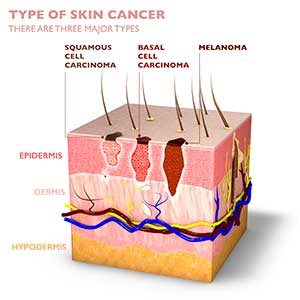Basal Cell Carcinoma Stages

Although most cancers are assigned stages, basal cell carcinoma is seldom staged. That’s because it’s highly unlikely for basal cell carcinoma to spread, and the extent of a cancer’s spread is the primary consideration in most traditional staging models. Staging plays a significant role in how most other cancers are treated, but most non-metastatic basal cell carcinomas can be successfully treated through a similar combination of therapies.
How is basal cell carcinoma staged?
In rare situations, such as when the original lesion is more than 2 millimeters thick, or when it has invaded the lower layers of the skin, a stage may be assigned. The stages range from zero to four; higher numbers indicate more aggressive cancers. Most oncologists use the following scale:
- Stage 0 basal cell carcinoma (carcinoma in situ) – These cancers are only present in the epidermis or the upper layer of the skin. They have not spread to any of the deeper layers or lymph nodes.
- Stage 1 basal cell carcinoma – These cancers are smaller than 2 centimeters and have not spread to any nearby lymph nodes or organs, but may have one factor that increases the risk of spreading or recurrence (e.g., it is on the ear or a hair-bearing lip, or it has grown into the small nerves in the skin).
- Stage 2 basal cell carcinoma – These cancers are larger than 2 centimeters, and while they have not spread to other organs or lymph nodes, they have two or more factors that make them likely to return or spread.
- Stage 3 basal cell carcinoma – These cancers have spread to local lymph nodes (or the facial bones), but not to other organs.
- Stage 4 basal cell carcinoma – These cancers have spread to several lymph nodes, bones or other organs, and they may be any size.
What are the most common symptoms of basal cell carcinoma?
As with other types of cancer, basal cell carcinoma is easier to treat when it’s diagnosed at an early stage. Indeed, in many cases, basal cell carcinoma can be effectively treated and cured. To ensure that you detect a malignancy as early as possible, it’s important to regularly examine your own skin and promptly reach out to a physician to discuss any abnormalities you notice.
What symptoms should you look for when performing a self-examination? Again, it’s important to take note of any new changes to your skin’s appearance, since they could also indicate the presence of a different condition. With that being said, basal cell carcinoma often causes skin blemishes or growths that don’t heal as quickly as expected (within approximately two months). These abnormalities may present as:
- A pearly bump that appears to be shiny or translucent
- A small, flat, firm growth that’s either pink, red, blue, brown or black
- A white, waxy patch resembling a scar
- A dome-shaped lesion that’s depressed at its center
- An elevated growth with visible blood vessels
You might also notice that a blemish appears to be healing, but then reappears, breaks down and once again starts bleeding easily. This continuous healing cycle can suggest the presence of basal cell carcinoma.
Where does basal cell carcinoma usually develop?
 Basal cell carcinoma most commonly develops in areas of the body that are frequently exposed to the sun or other sources of ultraviolet (UV) rays. These may include the:
Basal cell carcinoma most commonly develops in areas of the body that are frequently exposed to the sun or other sources of ultraviolet (UV) rays. These may include the:
- Head
- Ears
- Neck
- Shoulders
- Arms
- Hands
- Legs
This is not to say that basal cell carcinoma can’t develop in other areas of the body, including those that are never exposed to the sun. For instance, many individuals have developed basal cell carcinoma on their genitals or on the bottoms of their feet. For this reason, it’s important to check every inch of your body when performing your regular self-examination.
Moffitt’s approach to treating basal cell carcinoma
At Moffitt Cancer Center, we treat patients with all stages of basal cell carcinoma. Our skilled oncologists can determine whether a lesion is likely to spread and what treatments are expected to be most beneficial.
If you suspect that you have basal cell carcinoma or another type of cancer, you can feel confident entrusting your care to our skilled team. The oncologists in our Cutaneous Oncology Program focus exclusively on treating skin cancer, and they collaborate with dermatologists, plastic surgeons and various other specialists to develop individualized treatment plans that address patients’ specific needs and preferences. What’s more, as a National Cancer Institute-designated Comprehensive Cancer Center, we’re at the forefront of groundbreaking research, and our clinical trials program offers our patients access to a wide range of therapies in one convenient location.
Moffitt is proud to have disrupted the traditional patient care model. In order to provide our patients with the rapid care they deserve, we connect them with a cancer expert quickly. This helps us calm any fears that our patients may be experiencing and enables us to get started on treatment as soon as possible. Call us today at 1-888-663-3488 or complete a new patient registration form online to get started.
Diagnosis
